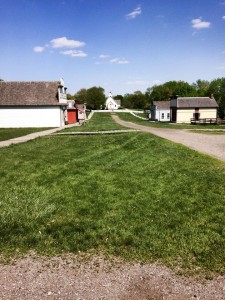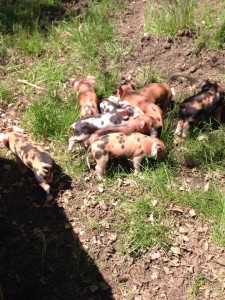Today was by far our most informational day with the pork industry in the morning and the biodiesel plant in the afternoon. Luckily it was also the first day we had with a free time slot that allowed some of the group to go to the nearby Friest farm to meet Brent, help tend the horses, etc. The first thing that I learned at the pork industry was that pork is now rarely raised from birth to market and is more often purchased as young pigs and raised to market instead. A lot of the time people will raise someone else’s hogs under contract so that there’s no real risk involved since they’re paid upfront. Although there’s easily over a hundred more things I could say about the hog industry talk after a 3 hour meet, I’ll leave it to the part that I paid the most attention to which was the environmental side of things. This was a meeting involving conventional or industrial hog farms (including CAFOs) and of course they want to give a positive view, but I feel like they had a good argument in the area in many respects. Working in concentrated areas has ethical implications (although keeping the animals comfortable and safe has taken a high priority in everything we’ve seen), it does come with some immediate environmental benefits. If it’s concentrated, then it needs much less land. Since transportation and machinery are the largest GHG emission involved in the hog industry concentrating it also decreases the greenhouse footprint and although not specifically explained, it also reduces the water requirements of the operation (water 41%, land 78%). The one concern I have with this is the possibility for a similar situation as a city’s footprint. In a city there is less land needed for a person to live, but land is needed to raise their food, store their food (groceries), mine their resources (including the coal or oil to transport the food the distance to the city), etc and they actually end up needing much more land to support them.
One of the major environmental problems with these types of operations is the manure becomes a waste product which does nothing but give off some of the compounds (some being GHG’s) which ordinarily would go into the soil. In Iowa they don’t just have large scale hog farms, but also have large amounts of crop farming, including a large amount of the feed corn and soy. Thanks to this, most pork farms here are able to sell their manure for fertilizer to the point where almost 1/4 of all fertilizer needs are met by manure in Iowa. This solves this problem and keeps the system of nutrient delivery back into the soil with the manure instead of treating manure as a waste. Although I’m sure there are either environmental concerns involved with concentrated hog farms, this is the biggest one I thought of and they completely eliminate the problem here in Iowa. The other problem I’ve heard has a lot less to do with the concentrated aspect and more to do with culture. Just having such large amounts of meat when the average person needs only a fist sized piece of meat (or protein rich veggies) is a large waste of resources. This is because of the 1/10 rule which roughly explains that for every 1 lbs of food one eats, we get about 10% of the energy within it (energy being nutrients, fats, etc which we can use to make energy). So every pig goes through this too and thus has to eat 10 lbs of corn to “grow” a pound of meat for us. This causes the problem of a less efficient diet where we need to grow more crops not for people, but to feed more animals to feed people. Not as much of a concentrated pig farm problem, but something along the same line of thought since you theoretically need to grow ten times the food if everyone went from strictly vegan to strictly carnivore diets. This applies with all animals including fish, so the higher on the food chain you go the less overall efficient you’re technically being (ie eating a plant you get 1/10 the energy it got from the sun, eating a pig you get 1/10 the energy it got from corn which was 1/10 the energy the corn got from the sun which leaves you with 1/100 the energy from the corns energy now).
After our long meeting at the pork industry we went to lunch and then the biodiesel/soymeal plant. Being a chemist I really enjoyed this tour as I had heard of many of the compounds before, even working with a handful of them. I was also interested to hear the plant’s main purpose was initially to crush soy into feed mix and the oil released is just a byproduct. Some facilities of theirs turn it into soy cooking oil, but this one turns it into fuel in a process which also produces glycerin, a compound used in cosmetics, food, and medicines. Most facilities like this focus on producing the biodiesel and will leave the glycerin crude and sell it to a refinery whereas this plant goes through the extra effort to fully process their glycerin, often buying glycerin from others for processing. Although I doubt many are interested in the chemical process like I was, but they essentially take the oil and remove the impurities (phosphorus, excess water, etc) through methanol washes and a few filtration runs. Glycerin is what’s left when the oil is processed and can then itself be separated just based on density (think olive oil on top of water) to be purified and sold. They also recovered as much of the material including water and methanol to reuse in their facility as possible, at least to the point where it makes economic sense to do so. I found it really cool I suppose to be able to understand not everything, but the gist of the information from a large chemical facility based on coursework and a small bit of research! Especially knowing some of the processes because I had done things like GC (gas chromatogram which essentially heats up what you put in it to analyze what was there to test for impurity) or salt washes. I doubt most others were very interested in this topic mainly because it was just a very technical tour, even with my background of chemistry a lot of it was so specific to biodiesel that I couldn’t keep up, but I love chemistry so I was kept interested the entire time. I have some personal concerns about turning food products into fuel (very simply the idea of all those nutrients literally being used to burn in an engine instead of going back to the soil for more plants to use), but in this facility the meal is made for farmers and this oil is just a side product which would otherwise be wasted. Many other smaller biodiesel plants I’ve heard of rely on used kitchen oil for their source, which is taking a waste and making it a valuable commodity. Things like this are what really interest me, that blend between an environmental effort (both reducing waste and making renewable fuel) and chemistry. In sum, I had a fun day as a nerd.
I’d like to add that I got to meet the nice neighbors the Friests, but I feel like this is already long enough so I’ll simply say I enjoyed their company, conversation, hospitality, and many pets.




